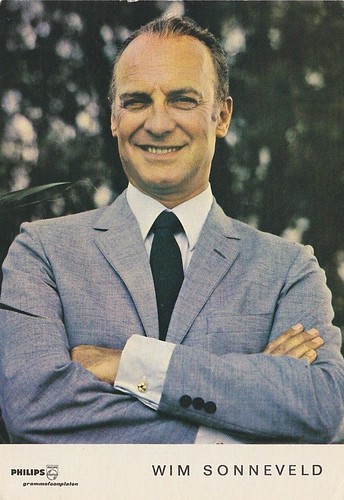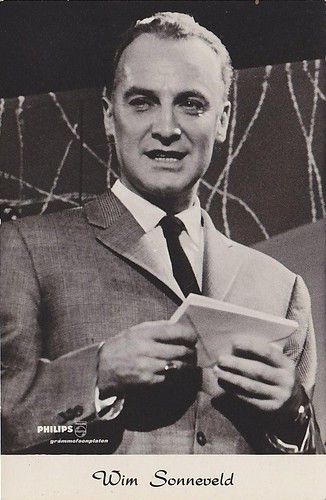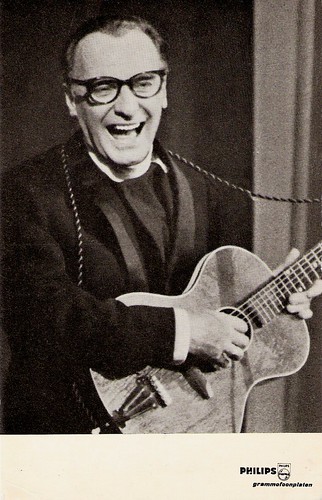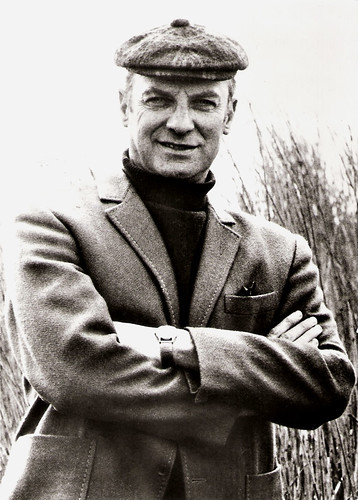Dutch cabaret artist and singer Wim Sonneveld (1917-1974) was one of the 'Legendary Three' of the Dutch post-war cabaret; the others were Toon Hermans and Wim Kan. He starred in a few films and had a brief Hollywood career.

Dutch postcard. Photo: Philips grammofoonplaten. Collection: Gé Joosten.
Willem Benedictus Augustinus Sonneveld was born in 1917 in Utrecht, the Netherlands, to Gerrit Sonneveld and Geertruida van den Berg. In 1922, at a very young age, Wim lost his mother.
In 1932 he started singing in an amateur choir, the Keep Smiling Singers, after which he teamed up in 1934 with Fons Goossens to form a duo and perform at anniversaries of associations and institutions.
Later that year he met reviewer Huub Janssen and after a journey through France in 1936 they started living together in Amsterdam. In the same year he made his stage debut with Louis Davids in the Hollandse Schouwburg in Amsterdam. He worked during the day as administrator and at evenings he played small roles and sang chansons.
In 1937 he went to France and sang in cabarets of Suzy Solidor and Agnes Capri. After the declaration of war of 1940 he returned to the Netherlands, where he acted in plays and in the revue of Loekie Bouwmeester.
In 1940 he performed in the Theater der Prominenten and at Abraham van der Vies' De Sprookjesspelers. Here he met singer Conny Stuart.
In 1943 he formed his own cabaret group Rim Ram, consisting among others of Conny Stuart, Lia Dorana, Albert Mol, Joop Doderer, Hetty Blok and Emmy Arbous. Between 1943 and 1959 he staged a great number of shows with Rim Ram.

Dutch postcard. Photo: Philips grammofoonplaten. Collection: Gé Joosten.
A famous creation of Wim Sonneveld was Willem Parel, son and grandson of a Dutch street organ grinder as well as chairman of the En-pé-gé, the Nederlands Parel Genootschap (the Dutch Parel Association). This character brought him great success first on stage and later on the VARA-radio.
Willem Parel would expose movingly about ‘organ grinding in general and the psychology of the penny cup in particular’. Over time Wim Sonneveld came to hate his creation, but he knew that Willem Parel drew a large audience and he couldn't live from just singing chansons.
In 1955 a film was shot called Het wonderlijke leven van Willem Parel/The Wondrous life of Willem Parel (Gerard Rutten, 1955). Sonneveld appeared as himself and narrated the film, until his 'Willem Parel' steps down from a poster on the dressing room wall and starts scolding his creator for trying to get rid of him.
The film didn't become the enormous success it was expected to be, but American casting agent Mitchell Gertz, saw it and offered Wim a contract in Hollywood. There he played in the TV thriller The Pink Hippopotamus (1956), the musical Silk stockings (Rouben Mamoulian, 1957) as a Russian opposite Fred Astaire, and Wasp End (1957).
Still, Sonneveld soon got homesick and returned to Europe. He admitted to prefer his homegrown audience instead of having to build a whole new one abroad.

Wim Sonneveld as Frater Venantius. Dutch postcard. Photo: Philips grammofoonplaten.
In 1958 Wim Sonneveld made eight TV shows in Great Britain for the BBC and in 1960 he starred as Dr. Higgins in the Dutch stage version of the musical My Fair Lady. With 702 performances, the musical was one of the most successful Dutch stage shows ever.
He then went solo with television shows like Doe es wat, meneer Sonneveld/Do Something, mr. Sonneveld (1962) and Blijf in Holland/Stay in Holland (1963). Wim Sonneveld again took the stage in 1964 with Een avond met Wim Sonneveld/An Evening With Wim Sonneveld.
For the Grand Gala Du Disc he created one of his famous characters, Frater Venantius (Friar Venantius). His record about the friar became a top 10 hit in 1965.
Remarkable were also his guest roles in the legendary TV series Ja zuster, nee zuster/Yes Nurse, No Nurse (1967), written by Annie M.G. Schmidt.
Two of his songs from the series became hit records: De kat van Ome Willem/Uncle Willem’s Cat (1968) and In een rijtuigje/In a Small Carriage (1968) which he sang with Leen Jongewaard.

Dutch postcard. Photo: Philips grammofoonplaten.
He did two more successful theatre shows: the first in 1967 with Ina van Faassen and the last one in 1971 with Willem Nijholt and Corrie van Gorp.
He also made another film, Op de Hollandse toer/Going Dutch (Harry Booth, 1973). Critics were quite harsh in their reviews of this picture and the public stayed away as well. The film was a financial catastrophe and later was even thought lost (but the original negative has survived).
In 1974 Wim Sonneveld died from a heart attack in the VU hospital in Amsterdam. He was only 56.
Even though Wim Sonneveld never publicly stated that he was homosexual, he shared his life only with men, first with Huub Janssen, later with prop designer, text writer and painter Friso Wiegersma whom he had met in 1947 and who created the famous character Nikkelen Nelis for him.
Scene from Het wonderlijke leven van Willem Parel/The Wondrous life of Willem Parel (1955). Wim Sonneveld sings Poen (Dough). Source: Crescendo1950 (YouTube).
Another scene from Het wonderlijke leven van Willem Parel (1955). Wim Sonneveld sings De wonderen zijn de wereld nog niet uit/There Are Still Wonders on Earth. Source: Crescendo 1950 (YouTube).
Wim Sonneveld as Nikkelen Nelis. Source: Kim Lempereur (YouTube).
Sources: Hilde Scholten (Een Leven Lang Theater) (Dutch), Wikipedia, and IMDb.

Dutch postcard. Photo: Philips grammofoonplaten. Collection: Gé Joosten.
Rim Ram
Willem Benedictus Augustinus Sonneveld was born in 1917 in Utrecht, the Netherlands, to Gerrit Sonneveld and Geertruida van den Berg. In 1922, at a very young age, Wim lost his mother.
In 1932 he started singing in an amateur choir, the Keep Smiling Singers, after which he teamed up in 1934 with Fons Goossens to form a duo and perform at anniversaries of associations and institutions.
Later that year he met reviewer Huub Janssen and after a journey through France in 1936 they started living together in Amsterdam. In the same year he made his stage debut with Louis Davids in the Hollandse Schouwburg in Amsterdam. He worked during the day as administrator and at evenings he played small roles and sang chansons.
In 1937 he went to France and sang in cabarets of Suzy Solidor and Agnes Capri. After the declaration of war of 1940 he returned to the Netherlands, where he acted in plays and in the revue of Loekie Bouwmeester.
In 1940 he performed in the Theater der Prominenten and at Abraham van der Vies' De Sprookjesspelers. Here he met singer Conny Stuart.
In 1943 he formed his own cabaret group Rim Ram, consisting among others of Conny Stuart, Lia Dorana, Albert Mol, Joop Doderer, Hetty Blok and Emmy Arbous. Between 1943 and 1959 he staged a great number of shows with Rim Ram.

Dutch postcard. Photo: Philips grammofoonplaten. Collection: Gé Joosten.
Silk Stockings
A famous creation of Wim Sonneveld was Willem Parel, son and grandson of a Dutch street organ grinder as well as chairman of the En-pé-gé, the Nederlands Parel Genootschap (the Dutch Parel Association). This character brought him great success first on stage and later on the VARA-radio.
Willem Parel would expose movingly about ‘organ grinding in general and the psychology of the penny cup in particular’. Over time Wim Sonneveld came to hate his creation, but he knew that Willem Parel drew a large audience and he couldn't live from just singing chansons.
In 1955 a film was shot called Het wonderlijke leven van Willem Parel/The Wondrous life of Willem Parel (Gerard Rutten, 1955). Sonneveld appeared as himself and narrated the film, until his 'Willem Parel' steps down from a poster on the dressing room wall and starts scolding his creator for trying to get rid of him.
The film didn't become the enormous success it was expected to be, but American casting agent Mitchell Gertz, saw it and offered Wim a contract in Hollywood. There he played in the TV thriller The Pink Hippopotamus (1956), the musical Silk stockings (Rouben Mamoulian, 1957) as a Russian opposite Fred Astaire, and Wasp End (1957).
Still, Sonneveld soon got homesick and returned to Europe. He admitted to prefer his homegrown audience instead of having to build a whole new one abroad.

Wim Sonneveld as Frater Venantius. Dutch postcard. Photo: Philips grammofoonplaten.
Friar Venantius
In 1958 Wim Sonneveld made eight TV shows in Great Britain for the BBC and in 1960 he starred as Dr. Higgins in the Dutch stage version of the musical My Fair Lady. With 702 performances, the musical was one of the most successful Dutch stage shows ever.
He then went solo with television shows like Doe es wat, meneer Sonneveld/Do Something, mr. Sonneveld (1962) and Blijf in Holland/Stay in Holland (1963). Wim Sonneveld again took the stage in 1964 with Een avond met Wim Sonneveld/An Evening With Wim Sonneveld.
For the Grand Gala Du Disc he created one of his famous characters, Frater Venantius (Friar Venantius). His record about the friar became a top 10 hit in 1965.
Remarkable were also his guest roles in the legendary TV series Ja zuster, nee zuster/Yes Nurse, No Nurse (1967), written by Annie M.G. Schmidt.
Two of his songs from the series became hit records: De kat van Ome Willem/Uncle Willem’s Cat (1968) and In een rijtuigje/In a Small Carriage (1968) which he sang with Leen Jongewaard.

Dutch postcard. Photo: Philips grammofoonplaten.
Going Dutch
He did two more successful theatre shows: the first in 1967 with Ina van Faassen and the last one in 1971 with Willem Nijholt and Corrie van Gorp.
He also made another film, Op de Hollandse toer/Going Dutch (Harry Booth, 1973). Critics were quite harsh in their reviews of this picture and the public stayed away as well. The film was a financial catastrophe and later was even thought lost (but the original negative has survived).
In 1974 Wim Sonneveld died from a heart attack in the VU hospital in Amsterdam. He was only 56.
Even though Wim Sonneveld never publicly stated that he was homosexual, he shared his life only with men, first with Huub Janssen, later with prop designer, text writer and painter Friso Wiegersma whom he had met in 1947 and who created the famous character Nikkelen Nelis for him.
Scene from Het wonderlijke leven van Willem Parel/The Wondrous life of Willem Parel (1955). Wim Sonneveld sings Poen (Dough). Source: Crescendo1950 (YouTube).
Another scene from Het wonderlijke leven van Willem Parel (1955). Wim Sonneveld sings De wonderen zijn de wereld nog niet uit/There Are Still Wonders on Earth. Source: Crescendo 1950 (YouTube).
Wim Sonneveld as Nikkelen Nelis. Source: Kim Lempereur (YouTube).
Sources: Hilde Scholten (Een Leven Lang Theater) (Dutch), Wikipedia, and IMDb.
No comments:
Post a Comment